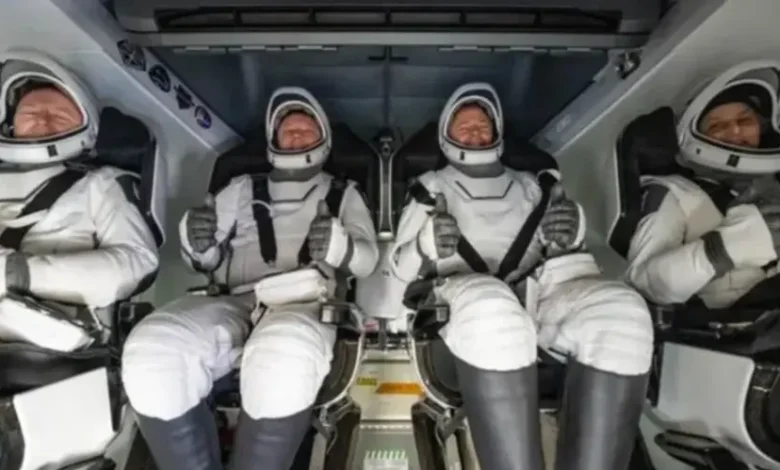Cancer risk and “chicken legs”: experts talked about NASA astronauts and how space affects the human body

Nine months in space is a real test for the human body, which turns into an experimental object. It was with such extreme physiological and psychological consequences that NASA astronauts Butch Wilmore and Sunita Williams faced after their return to Earth, they spent 286 days on the International Space Station. Their mission aboard the International Space Station lasted much longer than planned, which caused serious concern for doctors and scientists. The way the human body changes in the conditions of microgravity amazes the imagination and makes you think about the reality of long space flights. Experts shared professional assessments of what actually happens to the human body in space, and told how a long space flight causes a number of serious and sometimes irreversible health consequences.
Muscle atrophy and bone loss
As soon as the SpaceX Crew Dragon capsule landed, doctors helped the astronauts out and carried them on a stretcher for further examination. They will undergo a course of intensive medical supervision at the Johnson Space Center in Houston.
Experts call the rapid loss of muscle strength and bone density one of the most dangerous consequences of a long stay in space. Due to the absence of gravity, even with mandatory two-hour daily training, astronauts inevitably lose muscle mass. According to NASA scientists, in six months in weightlessness, a person can lose up to 50% of his strength. That is why after landing the crew of the SpaceX Crew Dragon capsule had to be evacuated on stretchers. People were physically unable to stand on their feet.
A study by the University of Calgary in Canada found that astronauts lose 1% to 2% of their bone density every month. This means that after nine months in space, their bones become as brittle as those of an 80-year-old. The consequences are osteoporosis, risk of fractures and long rehabilitation. NASA confirms that the return to the original state can take years.
Changes in fluid distribution: “swollen face” and “chicken legs”
In conditions of microgravity, fluids in the body are redistributed — they rise to the upper part of the body. This causes the so-called “swollen face” effect and a decrease in the volume of the legs, which NASA calls “chicken legs” or “baby feet”. Such a condition not only affects the appearance, but also creates risks for health, in particular, it increases the probability of thrombosis. Experts indicate that microgravity can trigger space venous thrombosis (SVT). In some cases, it resolves on its own after returning to Earth, but sometimes requires treatment.
Changes in appetite, weight loss and exhaustion
One of the serious problems of long-duration space missions is a sharp reduction in weight. Due to changes in taste sensations and constant nausea, astronauts lose their appetite. In September, doctors noticed that Sunita Williams looked extremely exhausted. According to NASA, the agency even tried to stabilize her weight during the mission. Despite all efforts, the astronauts returned to Earth much thinner, which was visible even in the first photos after landing.
Photo: thesun.co.uk
Problems with vision and eye pressure
Scientists have confirmed that microgravity causes serious vision problems. Due to the redistribution of fluids, blood and lymph put pressure on the eyeballs, causing them to be squeezed and deformed. This results in vision impairment that can last up to three months after returning to Earth. In some cases, changes in the structure of the eyes can be irreversible.
Atrophy of the heart and a decrease in blood volume
Another disturbing consequence of long missions in space is changes in the work of the heart. Following the example of astronaut Scott Kelly, who spent 340 days on the ISS, NASA found that even daily two-hour training does not prevent heart atrophy. Microgravity leads to a decrease in the general circulation of fluids in the body, the heart loses muscle mass, and blood volume decreases. This seriously reduces the function of the cardiovascular system, and recovery takes a long time.
Increased risk of cancer due to radiation
Doctors and scientists also said that one of the most dangerous threats in space is radiation exposure. In just one week on the ISS, an astronaut receives such a dose of radiation as he would receive in a year on Earth. This danger is perhaps the worst, since radiation damages DNA and increases the risk of cancer. The level of threat depends on the duration of the mission — the longer an astronaut is in space, the greater the risks.
“Baby’s skin” is the increased sensitivity of the body
Another little-known, but characteristic change after long flights is the appearance of the so-called “baby skin”. In weightlessness, clothes almost do not touch the body, so the skin of astronauts becomes hypersensitive, like babies. After returning, any contact with the fabric causes discomfort — the clothes seem rough and unpleasant. This effect can last for some time until the body gets used to Earth conditions again.
Deterioration of cognitive abilities and “slow brain”
Scientists have told about recent studies, according to which even in space the human brain does not remain unchanged. Scientists analyzed the condition of 25 astronauts and found that their reaction time slows down, attention and working memory weaken. In some cases, these changes persist even after returning to Earth. Microgravity and the lack of natural stimuli affect cognitive activity, and the brain needs time to fully recover.
So, 286 days in space turned astronauts into patients who will now have to fight to restore their own health. According to official data from NASA, Butch Wilmore and Sunita Williams have at least 45 days of intensive rehabilitation ahead of them under the supervision of doctors at the Johnson Space Center in Houston. However, as experts admit, full recovery will take more than one month, and some consequences of this flight may remain with the astronauts for the rest of their lives.





